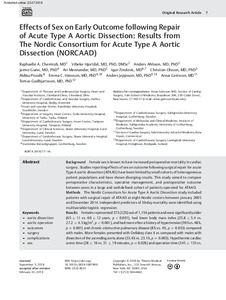Effects of Sex on Early Outcome following Repair of Acute Type A Aortic Dissection: Results from The Nordic Consortium for Acute Type A Aortic Dissection (NORCAAD)
Hjortdal V; Hansson EC; Gudbjartsson T; Chemtob RA; Jeppsson A; Pivodic A; Mennander A; Gunn J; Zindovic I; Geirsson A; Ahlsson A; Olsson C
https://urn.fi/URN:NBN:fi-fe2021042827394
Tiivistelmä
Background Female sex is known to have increased perioperative mortality in cardiac surgery. Studies reporting effects of sex on outcome following surgical repair for acute Type A aortic dissection (ATAAD) have been limited by small cohorts of heterogeneous patient populations and have shown diverging results. This study aimed to compare perioperative characteristics, operative management, and postoperative outcome between sexes in a large and well-defined cohort of patients operated for ATAAD.
Methods The Nordic Consortium for Acute Type A Aortic Dissection study included patients with surgical repair of ATAAD at eight Nordic centers between January 2005 and December 2014. Independent predictors of 30-day mortality were identified using multivariable logistic regression.
Results Females represented 373 (32%) out of 1,154 patients and were significantly older (65 ± 11 vs. 60 ± 12 years, p < 0.001), had lower body mass index (25.8 ± 5.4 vs. 27.2 ± 4.3 kg/m2, p < 0.001), and had more often a history of hypertension (59% vs. 48%, p = 0.001) and chronic obstructive pulmonary disease (8% vs. 4%, p = 0.033) compared with males. More females presented with DeBakey class II as compared with males with dissection of the ascending aorta alone (33.4% vs. 23.1%, p = 0.003). Hypothermic cardiac arrest time (28 ± 16 vs. 31 ± 19 minutes, p = 0.026) and operation time (345 ± 133 vs. 374 ± 135 minutes, p < 0.001) were shorter among females. There was no difference between the sexes in unadjusted intraoperative death (9.1% vs. 6.7%, p = 0.17) or 30-day mortality (17.7% vs. 17.4%, p = 0.99). In a multivariable analysis including perioperative factors influencing mortality, no difference was found between females and males in 30-day mortality (odds ratio: 0.92, 95% confidence interval: 0.62–1.38, p = 0.69).
Conclusions This study found no association between sex and early mortality following surgery for ATAAD, despite females being older and having more comorbidities, yet also presenting with a less widespread dissection than males.
Kokoelmat
- Rinnakkaistallenteet [19204]
